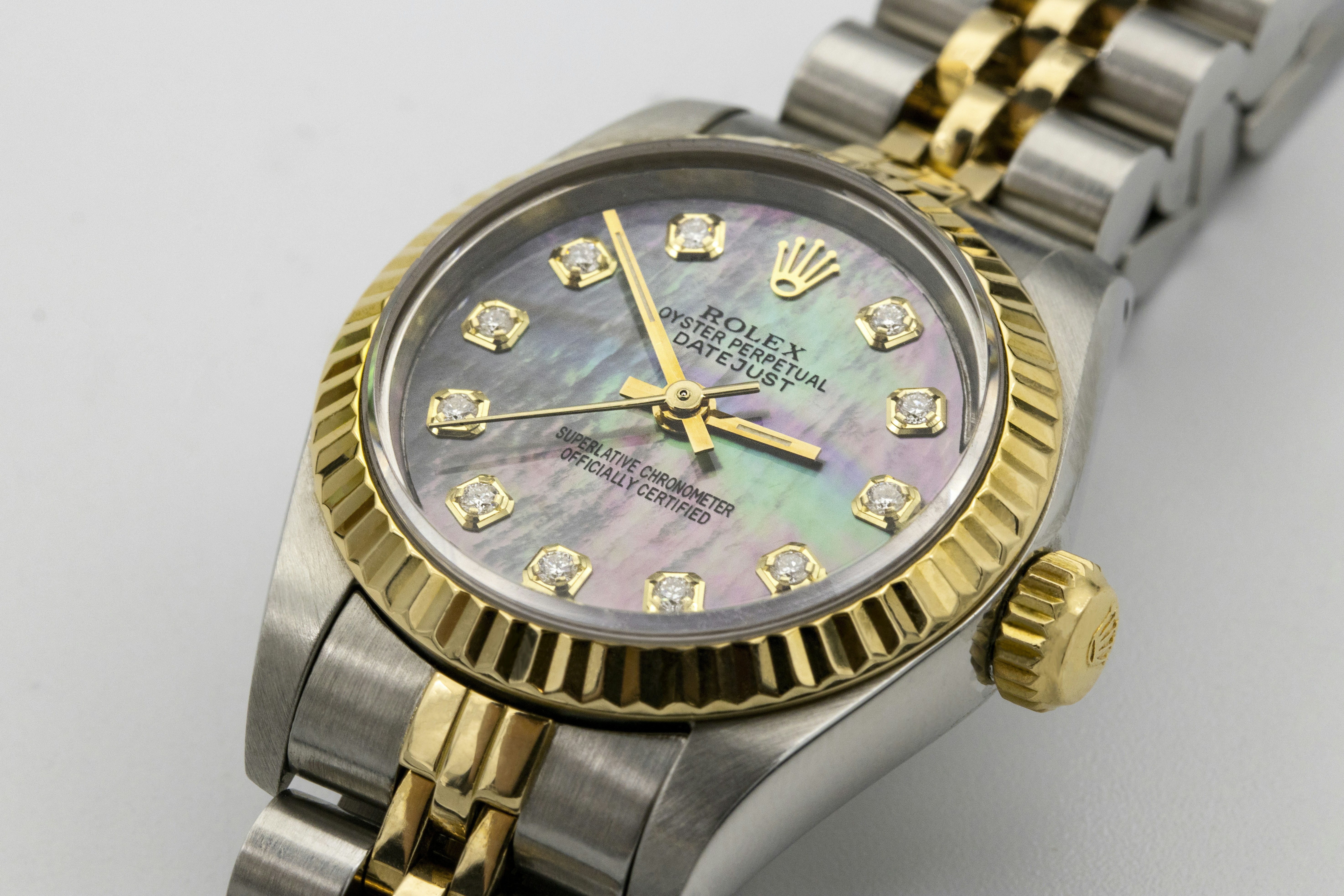The Birth of an Icon: Origins of the Royal Oak
The Audemars Piguet Royal Oak, first introduced in 1972, emerged during a time of significant turmoil in the luxury watch industry. The 1970s faced an unprecedented crisis as the advent of quartz technology began to threaten traditional mechanical watchmaking. Established brands struggled to adapt to the changing market dynamics, and many famous names faced potential extinction. It was against this backdrop that Audemars Piguet saw an opportunity to innovate and diversify its offerings.
To address the demand for a new kind of timepiece, the company enlisted the help of renowned designer Gérald Genta. Genta’s visionary approach led to the creation of a watch that would redefine luxury sports timepieces. The Royal Oak was not just any watch; it was a bold statement piece, combining the refinement of haute horlogerie with the robustness suitable for casual wear. This duality was captured in its iconic octagonal bezel and ‘Tapisserie’ patterned dial, elements that gracefully balanced elegance with sportiness.
Upon its release, the Royal Oak faced skepticism from both consumers and the industry. Priced at a remarkable 3,650 Swiss francs—the equivalent of a luxury gold watch—many wondered who would invest in a stainless-steel timepiece. However, Audemars Piguet’s daring design began to attract attention, as it successfully conveyed both prestige and modernity. As a pioneering model, it soon found favor with a clientele eager for distinction in a landscape of monotonous watch designs.
The Royal Oak’s early challenges were swiftly overshadowed by its eventual acceptance and popularity. Over time, it carved a significant niche in the watchmaking landscape, demonstrating that traditional craftsmanship could harmonize with cutting-edge innovation. This iconic timepiece not only survives but thrives, a testament to its enduring appeal and the foresight of its creators.
Design Elements That Captivated the World
The Audemars Piguet Royal Oak stands as a remarkable testament to the artistry and innovation in watchmaking, characterized by distinct design elements that have enamored enthusiasts and collectors alike. One of the most recognizable features of the Royal Oak is its unique octagonal bezel, a departure from traditional round watch designs. This bold architectural choice not only enhances the watch’s aesthetic appeal but also signifies its pioneering spirit, as it boldly defied the norms of luxury timepieces at the time of its launch in 1972.
Equally captivating is the ‘Tapisserie’ patterned dial, which adds depth and texture to the watch face. This intricate checkered pattern, available in various colors, creates a mesmerizing play of light and shadow, further elevating the visual experience of the Royal Oak. The Tapisserie design serves not only an aesthetic purpose but also contributes to functional aspects, such as improving legibility while showcasing the watch’s craftsmanship.
Moreover, the integration of the metal bracelet with the case symbolizes a harmonious design philosophy that prioritizes comfort without sacrificing style. The seamlessly crafted links mirror the octagonal bezel, presenting a unified design language that is both elegant and robust. This approach has not only set a benchmark in the wristwatch industry but has also inspired contemporary designs, as many brands strive to achieve a similar cohesiveness in their timepieces.
The thoughtful combination of these elements characterizes the timeless elegance of the Audemars Piguet Royal Oak. By merging aesthetic appeal with functional innovation, the design ensures that the Royal Oak transcends trends and remains a symbol of luxury and sophistication in the modern watch market.
The Evolution of the Royal Oak: Milestones and Variants
The Audemars Piguet Royal Oak has undergone significant evolution since its inception. Launched in 1972, the Royal Oak was a groundbreaking timepiece designed by Gérald Genta. It introduced an innovative octagonal bezel and a unique integrated bracelet, setting a new standard for luxury watches. The initial model faced skepticism, but it quickly transformed into a coveted icon in the Swiss watchmaking industry.
One of the critical milestones in the Royal Oak’s evolution was the introduction of the Royal Oak Offshore in 1993. This model was designed with a more robust appeal, featuring a larger case and a sportier design. The Royal Oak Offshore successfully attracted a new demographic and cemented its place as a fashionable choice among sports enthusiasts and celebrities, thereby expanding the Royal Oak’s influence beyond traditional watch collectors.
Another essential aspect of the Royal Oak’s evolution is the introduction of unique limited editions and complications. Audemars Piguet has consistently released special models to entice collectors, showcasing its commitment to craftsmanship and innovation. Noteworthy examples include the Royal Oak Concept and various collaborations with high-profile athletes and artists, reflecting both the brand’s heritage and modern sensibilities.
As consumer preferences continue to evolve, Audemars Piguet has seamlessly integrated technological advancements while paying homage to its roots. The introduction of materials such as ceramic and titanium in newer models highlights the brand’s dedication to innovation. The Royal Oak has adapted to contemporary trends without compromising its core identity, ensuring it remains a prestigious timepiece that resonates with watch enthusiasts worldwide. This ongoing evolution reflects Audemars Piguet’s dedication to excellence and its ability to navigate the ever-changing landscape of luxury watchmaking.
The Royal Oak’s Cultural Impact and Enduring Legacy
The Audemars Piguet Royal Oak transcends the world of horology, establishing itself as a significant cultural icon since its debut in 1972. Its unique design, characterized by the distinctive octagonal bezel and “Tapisserie” patterned dial, has not only captivated connoisseurs of fine watchmaking but also resonated with the fashionable elite. This blend of artistry and craftsmanship has led to its adoption by numerous celebrities, from entertainers to athletes, contributing to the Royal Oak’s status as a symbol of sophistication and success.
In popular culture, the Royal Oak has made its mark through various forms of media, including films and music videos, further solidifying its presence beyond luxury watchmaking. High-profile personalities such as NBA star LeBron James and musician Jay-Z have been seen sporting the Royal Oak, effectively elevating its appeal and desirability. As a result, the timepiece has become synonymous with a lifestyle that embodies both elegance and exclusivity.
The Royal Oak’s impact extends into the realm of luxury branding, where it has effectively set a benchmark for sporty yet refined timepieces. It has redefined the concept of luxury watches, blending the lines between formal and casual, allowing it to fit seamlessly into various social contexts. This versatility has not only fascinated watch collectors but has also garnered the attention of new enthusiasts who appreciate its historical significance and modern innovation.
Moreover, the Royal Oak has significantly contributed to Audemars Piguet’s prestigious reputation within the watch industry. Its success sparked a resurgence of interest in luxury sports watches, inspiring other brands to innovate and elevate their offerings. As a result, the legacy of the Royal Oak continues to thrive, ensuring its position as a timeless icon that will undoubtedly influence future generations of watchmakers and collectors alike.














